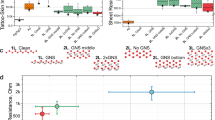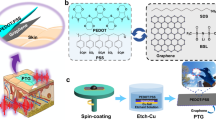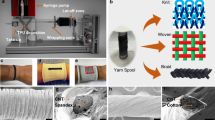Abstract
Numerous fields of science and technology, including healthcare, robotics and bioelectronics, have begun to switch their research direction from developing ‘high-end, high-cost’ tools towards ‘high-end, low-cost’ solutions. Graphene electronic tattoos (GETs), whose fabrication protocol is discussed in this work, are ideal building blocks of future wearable technology due to their outstanding electromechanical properties. The GETs are composed of high-quality, large-scale graphene that is transferred onto tattoo paper, resulting in an electronic device that is applied onto skin like a temporary tattoo. Here, we provide a comprehensive GET fabrication protocol, starting from graphene growth and ending with integration onto human skin. The methodology presented is unique since it utilizes high-quality electronic-grade graphene, while the processing is done by using low-cost and off-the-shelf methods, such as a mechanical cutter plotter. The GETs can be either used in combination with advanced scientific equipment to perform precision experiments, or with low-cost electrophysiology boards, to conduct similar operations from home. In this protocol, we showcase how GETs can be applied onto the human body and how they can be used to obtain a variety of biopotentials, including electroencephalogram (brain waves), electrocardiogram (heart activity), electromyogram (muscle activity), as well as monitoring of body temperature and hydration. With graphene available from commercial sources, the whole protocol consumes ~3 h of labor and does not require highly trained personnel. The protocol described in this work can be readily replicated in simple laboratories, including high school facilities.
This is a preview of subscription content, access via your institution
Access options
Access Nature and 54 other Nature Portfolio journals
Get Nature+, our best-value online-access subscription
$29.99 / 30 days
cancel any time
Subscribe to this journal
Receive 12 print issues and online access
$259.00 per year
only $21.58 per issue
Buy this article
- Purchase on Springer Link
- Instant access to full article PDF
Prices may be subject to local taxes which are calculated during checkout














Similar content being viewed by others
Data availability
Source data are provided with this paper.
References
Flores, M., Glusman, G., Brogaard, K., Price, N. D. & Hood, L. P4 medicine: how systems medicine will transform the healthcare sector and society. Per. Med. 10, 565–576 (2013).
Becker, S. et al. mHealth 2.0: experiences, possibilities, and perspectives. JMIR mHealth uHealth 2, e24 (2014).
Chow, C. K., Ariyarathna, N., Islam, S. M. S., Thiagalingam, A. & Redfern, J. mHealth in cardiovascular health care. Heart Lung Circ. 25, 802–807 (2016).
Price, M. et al. mHealth: A mechanism to deliver more accessible, more effective mental health care. Clin. Psychol. Psychother. 21, 427–436 (2014).
Ray, T. R. et al. Bio-integrated wearable systems: a comprehensive review. Chem. Rev. 119, 5461–5533 (2019).
Mukhopadhyay, S. C. Wearable sensors for human activity monitoring: a review. IEEE Sens. J. 15, 1321–1330 (2015).
Heikenfeld, J. et al. Wearable sensors: modalities, challenges, and prospects. Lab Chip 18, (2017).
Neethirajan, S. Recent advances in wearable sensors for animal health management. Sens. Bio-Sensing Res 12, 15–29 (2017).
Guk, K. et al. Evolution of wearable devices with real-time disease monitoring for personalized healthcare. Nanomaterials 9, 1–23 (2019).
Wearable Technology Market—Growth, Trends, and Forecasts (2020–2025). https://www.researchandmarkets.com/reports/4591296/wearable-technology-market-growth-trends-and
Wang, C. et al. Monitoring of the central blood pressure waveform via a conformal ultrasonic device. Nat. Biomed. Eng. 2, 687–695 (2018).
Kim, D.-H. et al. Epidermal electronics. Science 333, 838–843 (2011).
Gutruf, P. et al. Fully implantable optoelectronic systems for battery-free, multimodal operation in neuroscience research. Nat. Electron. 1, 652–660 (2018).
Miro, P. et al. An atlas of two-dimensional materials. Chem. Soc. Rev. 43, 6537–6554 (2014).
Ferrari, A. C. et al. Science and technology roadmap for graphene, related two-dimensional crystals, and hybrid systems. Nanoscale 7, 4598–4810 (2015).
Chhowalla, M., Jena, D. & Zhang, H. Two-dimensional semiconductors for transistors. Nat. Rev. Mater 1, 16052 (2016).
Bhimanapati, G. R. et al. Recent advances in two-dimensional materials beyond graphene. ACS Nano 9, 11509–11539 (2015).
Kireev, D., Offenhaeusser, A. & Offenhäusser, A. Graphene & two-dimensional devices for bioelectronics and neuroprosthetics. 2D Mater 5, 042004 (2018).
Hess, L. H., Seifert, M. & Garrido, J. A. Graphene transistors for bioelectronics. Proc. IEEE 101, 1780–1792 (2013).
Kireev, D. et al. Graphene transistors for interfacing with cells: towards a deeper understanding of liquid gating and sensitivity. Sci. Rep. 7, 6658 (2017).
Kireev, D. et al. Graphene multielectrode arrays as a versatile tool for extracellular measurements. Adv. Healthc. Mater. 6, 1601433 (2017).
Kabiri Ameri, S. et al. Graphene electronic tattoo sensors. ACS Nano 11, 7634–7641 (2017).
Ameri, S. K. et al. Imperceptible electrooculography graphene sensor system for human–robot interface. npj 2D Mater. Appl. 2, 19 (2018).
Sel, K. et al. Electrical characterization of graphene-based e-tattoos for bio-impedance-based physiological sensing. BioCAS 2019 - Biomed. Circuits Syst. Conf. Proc. 1–4 (2019). https://doi.org/10.1109/BIOCAS.2019.8919003
Zhang, X. et al. Ultrasensitive field‐effect biosensors enabled by the unique electronic properties of graphene. Small 16, 1902820 (2020).
Huang, H. et al. Graphene-based sensors for human health monitoring. Front. Chem. 7, 1–26 (2019).
Wassei, J. K. & Kaner, R. B. Graphene, a promising transparent conductor. Mater. Today 13, 52–59 (2010).
Das, T., Sharma, B. K., Katiyar, A. K. & Ahn, J.-H. H. Graphene-based flexible and wearable electronics. J. Semicond. 39, 011007 (2018).
Park, D. et al. Fabrication and utility of a transparent graphene neural electrode array for electrophysiology, in vivo imaging, and optogenetics. Nat. Protoc. 11, 2201–2222 (2016).
Song, J.-K. et al. Wearable force touch sensor array using a flexible and transparent electrode. Adv. Funct. Mater. 27, 1605286 (2017).
Yang, S. et al. “Cut-and-paste” manufacture of multiparametric epidermal sensor systems. Adv. Mater. 27, 6423–6430 (2015).
Wang, Y. et al. Low-cost, μm-thick, tape-free electronic tattoo sensors with minimized motion and sweat artifacts. npj Flex. Electron. 2, 6 (2018).
Stier, A. et al. Stretchable tattoo-like heater with on-site temperature feedback control. Micromachines 9, 170 (2018).
Bae, S. et al. Roll-to-roll production of 30-inch graphene films for transparent electrodes. Nat. Nanotechnol. 5, 574–578 (2010).
DiMarco, J. P. & Philbrick, J. T. Use of ambulatory electrocardiographic (Holter) monitoring. Ann. Intern. Med. 113, 53–68 (1990).
Montain, S. J. & Ely, M. Water Requirements and Soldier Hydration (Borden Institute). https://ke.army.mil/bordeninstitute/other_pub/hydrationpdf.pdf
Sawka, M. N., Cheuvront, S. N. & Kenefick, R. W. High skin temperature and hypohydration impair aerobic performance. Exp. Physiol. 97, 327–332 (2012).
Kumari, P., Mathew, L. & Syal, P. Increasing trend of wearables and multimodal interface for human activity monitoring: a review. Biosens. Bioelectron. 90, 298–307 (2017).
Barea Navarro, R., Boquete Vázquez, L. & López Guillén, E. EOG-based wheelchair control. in Smart Wheelchairs and Brain-Computer Interfaces 381–403 (Elsevier, 2018). https://doi.org/10.1016/B978-0-12-812892-3.00016-9
Sel, K., Ibrahim, B. & Jafari, R. ImpediBands: body coupled bio-impedance patches for physiological sensing proof of concept. IEEE Trans. Biomed. Circuits Syst. 14, 757–774 (2020).
Ibrahim, B. & Jafari, R. A novel method for continuous blood pressure monitoring using wrist-worn bio-impedance sensors. 2018 IEEE Biomed. Circuits Syst. Conf. BioCAS 2018 - Proc. 3–6 (2018). https://doi.org/10.1109/BIOCAS.2018.8584783
Masvidal-Codina, E. et al. High-resolution mapping of infraslow cortical brain activity enabled by graphene microtransistors. Nat. Mater. 18, 280–288 (2019).
Polat, E. O. et al. Flexible graphene photodetectors for wearable fitness monitoring. Sci. Adv. 5, eaaw7846 (2019).
Miao, P. et al. Graphene nanostructure-based tactile sensors for electronic skin applications. Nano-Micro Lett 11, 71 (2019).
Saccomandi, P. et al. Microfabricated tactile sensors for biomedical applications: a review. Biosensors 4, 422–448 (2014).
Chortos, A., Liu, J. & Bao, Z. Pursuing prosthetic electronic skin. Nat. Mater. 15, 937–950 (2016).
Chang, T. H., Li, K., Yang, H. & Chen, P. Y. Multifunctionality and mechanical actuation of 2D materials for skin-mimicking capabilities. Adv. Mater. 30, 1–13 (2018).
Akinwande, D., Petrone, N. & Hone, J. Two-dimensional flexible nanoelectronics. Nat. Commun. 5, 5678 (2014).
Qiao, Y. et al. Graphene-based wearable sensors. Nanoscale 11, 18923–18945 (2019).
Amjadi, M., Kyung, K.-U., Park, I. & Sitti, M. Stretchable, skin-mountable, and wearable strain sensors and their potential applications: a review. Adv. Funct. Mater. 26, 1678–1698 (2016).
Jang, H., Dai, Z., Ha, K.-H., Ameri, S. K. & Lu, N. Stretchability of PMMA-supported CVD graphene and of its electrical contacts. 2D Mater 7, 014003 (2019).
Yetisen, A. K., Martinez-Hurtado, J. L., Ünal, B., Khademhosseini, A. & Butt, H. Wearables in medicine. Adv. Mater. 30, e1706910 (2018).
Tricoli, A., Nasiri, N. & De, S. Wearable and miniaturized sensor technologies for personalized and preventive medicine. Adv. Funct. Mater. 27, 1–19 (2017).
Griss, P., Tolvanen-Laakso, H. K., Meriläinen, P. & Stemme, G. Characterization of micromachined spiked biopotential electrodes. IEEE Trans. Biomed. Eng. 49, 597–604 (2002).
Kirkup, L. & Searle, A. A direct comparison of wet, dry and insulating bioelectric recording electrodes. Physiol. Meas. 21, 271 (2000).
Giffney, T., Bejanin, E., Kurian, A. S., Travas-Sejdic, J. & Aw, K. Highly stretchable printed strain sensors using multi-walled carbon nanotube/silicone rubber composites. Sensors Actuators A Phys 259, 44–49 (2017).
Cheng, Y., Wang, R., Zhai, H. & Sun, J. Stretchable electronic skin based on silver nanowire composite fiber electrodes for sensing pressure, proximity, and multidirectional strain. Nanoscale 9, 3834–3842 (2017).
Herbert, R., Kim, J. H., Kim, Y. S., Lee, H. M. & Yeo, W. H. Soft material-enabled, flexible hybrid electronics for medicine, healthcare, and human-machine interfaces. Materials (Basel) 11, 187 (2018).
Kang, J., Tok, J. B. H. & Bao, Z. Self-healing soft electronics. Nat. Electron. 2, 144–150 (2019).
Bauer, S. et al. 25th anniversary article: A soft future: From robots and sensor skin to energy harvesters. Adv. Mater. 26, 149–162 (2014).
Pang, C., Lee, C. & Suh, K. Y. Recent advances in flexible sensors for wearable and implantable devices. J. Appl. Polym. Sci. 130, 1429–1441 (2013).
Nezakati, T., Seifalian, A., Tan, A. & Seifalian, A. M. Conductive polymers: opportunities and challenges in biomedical applications. Chem. Rev. 118, 6766–6843 (2018).
Bihar, E. et al. Fully printed all-polymer tattoo/textile electronics for electromyography. Flex. Print. Electron. 3, 034004 (2018).
Ferrari, L. M. et al. Ultraconformable temporary tattoo electrodes for electrophysiology. Adv. Sci. 5, 1700771 (2018).
Yeo, W. H. et al. Multifunctional epidermal electronics printed directly onto the skin. Adv. Mater. 25, 2773–2778 (2013).
Huang, X., Yeo, W. H., Liu, Y. & Rogers, J. A. Epidermal differential impedance sensor for conformal skin hydration monitoring. Biointerphases 7, 1–9 (2012).
Gutruf, P. & Rogers, J. A. Implantable, wireless device platforms for neuroscience research. Curr. Opin. Neurobiol. 50, 42–49 (2018).
Ferrari, L. M., Ismailov, U., Badier, J.-M., Greco, F. & Ismailova, E. Conducting polymer tattoo electrodes in clinical electro- and magneto-encephalography. npj Flex. Electron. 4, 1–9 (2020).
Webb, R. C. et al. Ultrathin conformal devices for precise and continuous thermal characterization of human skin. Nat. Mater. 12, 938–944 (2013).
Bariya, M., Nyein, H. Y. Y. & Javey, A. Wearable sweat sensors. Nat. Electron. 1, 160–171 (2018).
Chung, H. J. et al. Stretchable, multiplexed pH sensors with demonstrations on rabbit and human hearts undergoing ischemia. Adv. Healthc. Mater. 3, 59–68 (2014).
Miyamoto, A. et al. Inflammation-free, gas-permeable, lightweight, stretchable on-skin electronics with nanomeshes. Nat. Nanotechnol. 12, 907–913 (2017).
Gong, S. et al. Local crack-programmed gold nanowire electronic skin tattoos for in-plane multisensor integration. Adv. Mater. 31, 1–8 (2019).
Ershad, F. et al. Ultra-conformal drawn-on-skin electronics for multifunctional motion artifact-free sensing and point-of-care treatment. Nat. Commun. 11, 3823 (2020).
Pan, C. et al. Visually imperceptible liquid-metal circuits for transparent, stretchable electronics with direct laser writing. Adv. Mater. 30, 1706937 (2018).
Childres, I., Jauregui, L. A., Tian, J. & Chen, Y. P. Effect of oxygen plasma etching on graphene studied using Raman spectroscopy and electronic transport measurements. New J. Phys. 13, 025008 (2011).
Liu, N. et al. Ultratransparent and stretchable graphene electrodes. Sci. Adv. 3, e1700159 (2017).
Acknowledgements
This work was supported in part by the Office of Naval Research grant N00014-18-1-2706. We also acknowledge the support, in part, of National Science Foundation (NSF) grant 2031674. We thank F. Qing of UESTC, and NASCENT-Grolltex collaboration for providing us with large-scale CVD-grown graphene.
Author information
Authors and Affiliations
Contributions
S.K.A., N.L. and D.A. conceived the idea and performed initial experiments. D.K. and S.K.A. optimized the procedure. D.K. and S.K.A. developed the protocol. D.K., S.K.A., A.N., H.J. and J.K. performed the experiments and analyzed the data. D.K. complied the data, wrote the manuscript, and designed the video supplements. All authors discussed the results and contributed to the editing of the manuscript.
Corresponding author
Ethics declarations
Competing interests
The authors declare no competing interests.
Additional information
Peer review information Nature Protocols thanks Mario Caironi, Wenlong Cheng and the other, anonymous, reviewer(s) for their contribution to the peer review of this work.
Publisher’s note Springer Nature remains neutral with regard to jurisdictional claims in published maps and institutional affiliations.
Related links
Key references using this protocol:
Kabiri Ameri, S. et al. ACS Nano 11, 7634–7641 (2017): https://doi.org/10.1021/acsnano.7b02182
Ameri, S. K. et al. npj 2D Mater. Appl. 2, 1–7 (2018): https://doi.org/10.1038/s41699-018-0064-4
Sel, K. et al. BioCAS 2019 - Biomed. Circuits Syst. Conf. Proc. 1–4 (2019): https://doi.org/10.1109/BIOCAS.2019.8919003
Supplementary information
Supplementary Information
Supplementary Tables 1 and 2.
Supplementary Video 1
Visual aid to help understanding procedure for Step 18 of the protocol – reversing graphene
Supplementary Video 2
Visual aid to help understanding procedure for Step 21 of the protocol – shaping GETs via Cameo plotter
Supplementary Video 3
Visual aid to help understanding procedure for Step 22 of the protocol – removing excess of graphene.
Supplementary Video 4
Visual aid to help understanding procedure for Step 24-Option A of the protocol – contacting GETs via copper tape
Supplementary Video 5
Visual aid to help understanding procedure for Step 24-Option B of the protocol – contacting GETs via silver epoxy
Supplementary Video 6
Visual aid to help understanding procedure for Step 25 – troubleshooting the GET transfer on skin
Source data
Source Data Fig. 1
Data files supporting the graphs, figures, plots.
Source Data Fig. 2
Data files supporting the graphs, figures, plots.
Source Data Fig. 11
Data files supporting the graphs, figures, plots.
Source Data Fig. 12
Data files supporting the graphs, figures, plots.
Source Data Fig. 13
Data files supporting the graphs, figures, plots.
Source Data Fig. 14
Data files supporting the graphs, figures, plots.
Rights and permissions
About this article
Cite this article
Kireev, D., Ameri, S.K., Nederveld, A. et al. Fabrication, characterization and applications of graphene electronic tattoos. Nat Protoc 16, 2395–2417 (2021). https://doi.org/10.1038/s41596-020-00489-8
Received:
Accepted:
Published:
Issue Date:
DOI: https://doi.org/10.1038/s41596-020-00489-8
This article is cited by
-
Eye tracking and eye expression decoding based on transparent, flexible and ultra-persistent electrostatic interface
Nature Communications (2023)
-
Low-temperature growth of MoS2 on polymer and thin glass substrates for flexible electronics
Nature Nanotechnology (2023)
-
Molecular-electromechanical system for unamplified detection of trace analytes in biofluids
Nature Protocols (2023)
-
Claw-shaped flexible and low-impedance conductive polymer electrodes for EEG recordings: Anemone dry electrode
Science China Technological Sciences (2023)
-
Liquid metal E-tattoo
Science China Technological Sciences (2023)
Comments
By submitting a comment you agree to abide by our Terms and Community Guidelines. If you find something abusive or that does not comply with our terms or guidelines please flag it as inappropriate.



